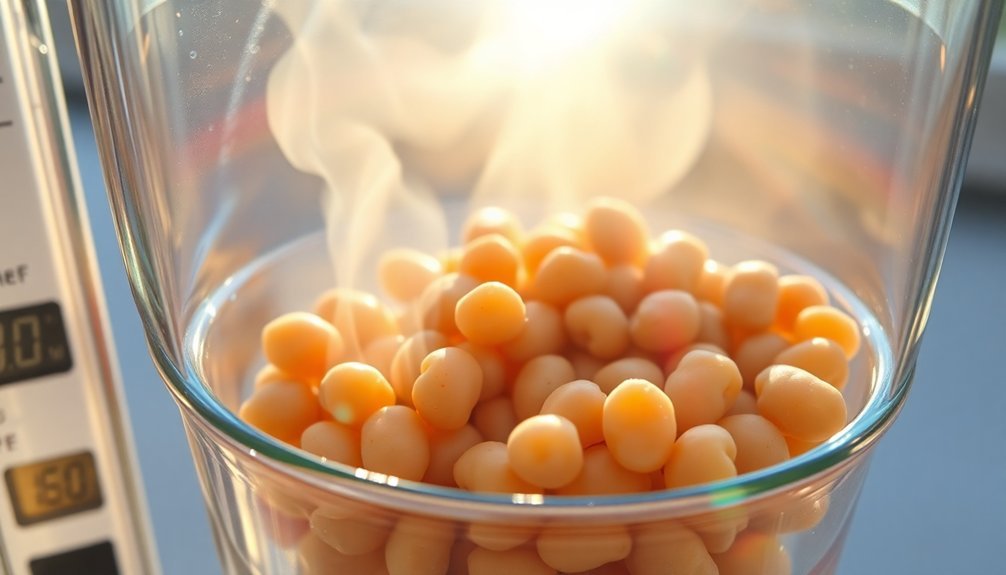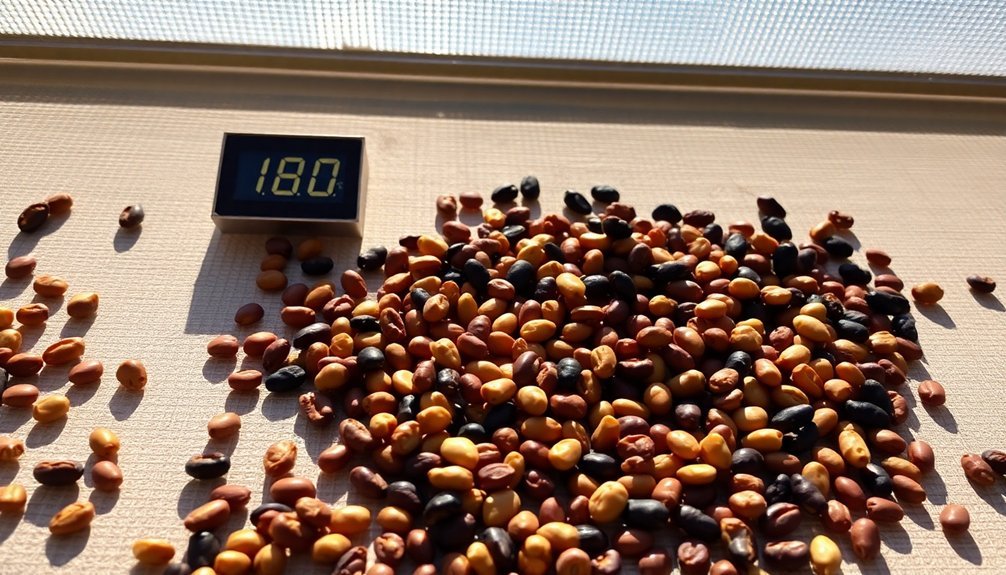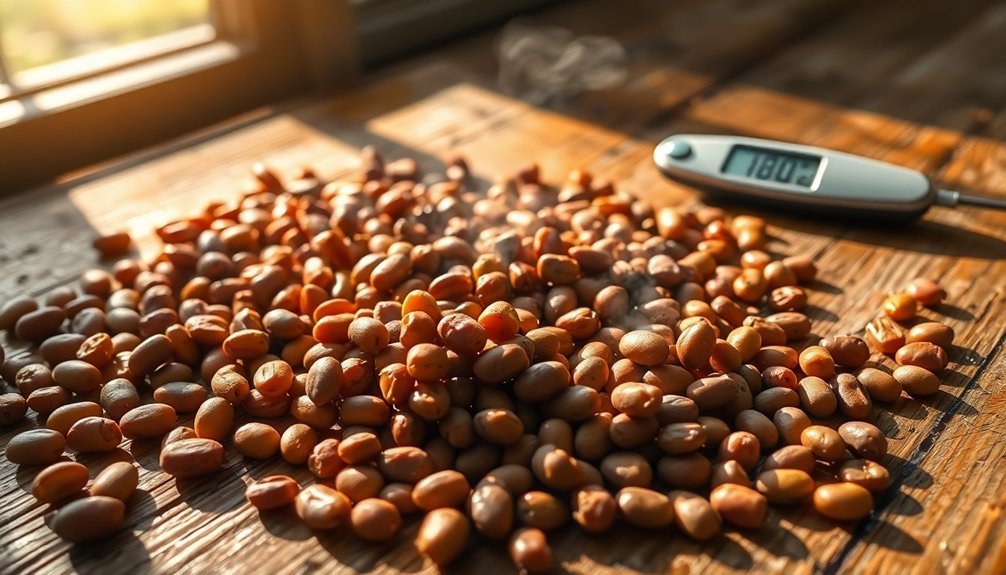Dried beans need 180°F solar heat because this temperature creates the perfect environment for breaking down tough fibers while preserving nutrients. You'll find that this gentle, consistent heat softens the beans' cell walls and pectin without destroying valuable compounds. The steady solar temperature guarantees even cooking, preventing the common problem of beans being too hard in some spots and mushy in others. Unlike aggressive boiling methods, solar heat at 180°F won't damage the beans' protective seed coats or cause nutrient loss. Understanding how this specific temperature works can transform your bean-cooking experience.
The Science Behind Bean Cooking

The science of cooking dried beans involves a careful balance of time, temperature, and technique to guarantee both safety and ideal results. You'll need to understand the critical role of heat in transforming raw beans into a safe, digestible food source.
The primary concern is phytohaemagglutinin, a toxic lectin that must be destroyed through proper cooking.
When you're preparing dried beans, you'll start with a 24-hour soak, which reduces cooking time by about 25% and helps remove unwanted compounds.
Once you've discarded the soaking liquid, you'll need to boil the beans for 30 minutes to denature toxic proteins.
Temperature control is vital – you must maintain at least 180°F (about 82°C) during the subsequent simmering phase, which can last up to 12 hours depending on your beans' characteristics.
The cooking environment greatly affects your results. Salt helps soften bean skins and speeds up cooking, while baking soda creates an alkaline environment that breaks down pectin more efficiently. Using a pressure cooker can dramatically reduce cooking time to just 20-40 minutes.
However, you'll want to avoid adding acidic ingredients until the end, as they'll slow down the cooking process by preventing pectin dissolution.
Solar Heat Temperature Benefits
When utilizing solar heat for drying beans, you'll find significant advantages in both temperature control and energy efficiency. The ideal temperature of 180°F (82°C) guarantees thorough dehydration while preserving essential nutrients and maintaining bean quality. Changing the soaking water during the preparation process helps reduce gas-causing compounds before drying begins.
While solar tunnel dryers typically reach temperatures up to 136°F (58°C), you can achieve higher temperatures by incorporating auxiliary heating systems.
You'll notice that proper temperature control directly impacts your beans' final quality. When you maintain consistent heat, you'll preserve more nutrients, retain better flavor and color, and achieve ideal texture. Additionally, you're reducing flatulence-causing enzymes through the proper drying process, making your beans more digestible.
Using solar drying systems can cut your drying time by up to 36% compared to traditional methods. You'll find these systems particularly cost-effective if you're a small-scale farmer, as they offer lower operating costs while producing higher quality beans that can command better market prices.
For best results, you'll want to guarantee proper ventilation throughout the drying process. If you're dealing with periods of low solar radiation, consider adding auxiliary heating to maintain consistent temperatures and maximize efficiency.
Achieving Perfect Bean Texture

Properly soaked and cooked beans deliver the perfect texture you're looking for in your culinary creations. You'll want to start with either a quick soak, traditional overnight soak, or hot soak method to prepare your beans. Each method helps reduce cooking time and improves digestibility while enhancing the beans' taste.
When you're ready to cook, rinse your soaked beans and use fresh water at a ratio of 6 cups of water for every 2 cups of dry beans. The cooking process works best when using a dark colored pot with a tight-fitting lid.
Solar ovens offer an excellent cooking method that preserves nutrients and guarantees even heating throughout the cooking process. You won't need to constantly monitor your beans as they cook, but you should adjust the oven's position periodically to maximize solar exposure.
The gentle, consistent heat from a solar oven breaks down complex molecules while maintaining nutritional value. You'll know your beans are perfectly cooked when they're soft and tender throughout.
Unlike conventional cooking methods, solar ovens prevent scorching and nutrient depletion, giving you beans that are both nutritious and easily digestible. The longer cooking times associated with solar ovens actually work in your favor, allowing the beans to develop their ideal texture gradually.
High Altitude Bean Cooking Adjustments
Cooking beans at high altitudes presents unique challenges due to lower boiling temperatures and extended cooking times. At 10,000 feet, water boils at just 194°F instead of the sea-level temperature of 212°F, which profoundly impacts your cooking process.
You'll need to increase your cooking times substantially at higher elevations. For every 4,000 feet of elevation, plan to add about an hour to your cooking time. Hot soaking your beans can provide maximum water absorption within two hours.
If you're using an electric pressure cooker, add 40% more cooking time for every 10,000 feet of elevation gain.
To optimize your high-altitude bean cooking, you'll want to pre-soak your beans and avoid adding salt until the end of cooking. Using a pressure cooker is your best option, but slow cookers can work well too if you maintain at least 2 inches of water above the beans.
If you're dealing with particularly stubborn beans, add a pinch of baking soda to the soaking water to help soften them.
Remember that water hardness can affect bean softening, so use fresh water if needed. Keep checking your beans regularly during cooking, as altitude, bean age, and water quality all influence cooking times.
Nutrient Preservation Through Solar Heat

Beyond altitude considerations, solar heat offers a remarkably effective way to preserve nutrients in dried beans. When you cook beans using solar heat, you're tapping into a gentle, natural warmth that mimics traditional cooking methods. This far-infrared heat penetrates beans evenly at around 180-200°F (80-93°C), breaking down complex carbohydrates while protecting essential nutrients.
You'll find that solar heat cooking preserves nutrients better than conventional methods through several key mechanisms:
- The lower cooking temperature (around 90°C) prevents nutrient degradation while maintaining the beans' structural integrity
- Solar ovens eliminate the need for vigorous boiling, which can damage seed coats and lead to nutrient loss
- Far-infrared heat effectively breaks down anti-nutrients while preserving beneficial compounds
Similar to traditional earthenware, pure clay pots provide optimal nutrient retention when used in solar cooking. You can maximize nutrient retention by using earthen cookware instead of metal pots, which can cause nutrient degradation. Don't discard the soaking water, as it contains valuable soluble vitamins and minerals.
Frequently Asked Questions
Can I Use Solar Cooking Methods for Beans During Cloudy Weather?
You can solar cook beans during cloudy weather, but it'll take longer and work best with insulated box ovens. For ideal results, you'll want to soak beans overnight and use thermal storage methods.
How Do You Prevent Beans From Fermenting During Long Solar Cooking?
You'll prevent bean fermentation by maintaining temperatures above 180°F, using less water, and cooking in pressure-resistant containers. Preheat your solar cooker, use dark cookware, and store cooked beans properly when finished.
What Backup Heating Methods Work Best if Solar Temperature Drops Suddenly?
You'll want to use electric heating elements as your primary backup – they're quick to respond and maintain precise temperatures. If that's not possible, thermal storage systems with PCMs can help sustain heat levels.
Does Bean Variety Affect Required Solar Cooking Temperature and Time?
Yes, your bean variety substantially impacts cooking time. You'll find larger beans need more time than smaller ones, but all still require at least 180°F. Cooking times can vary from 4-7 hours regardless.
Can Solar-Cooked Beans Be Safely Stored Longer Than Traditionally Cooked Beans?
No, your solar-cooked beans won't store longer than traditionally cooked ones. The storage duration depends on your storage method, not cooking technique. You'll get 3-4 days refrigerated or several months frozen for both.
In Summary
You'll find that cooking dried beans at 180°F using solar heat hits the sweet spot for several reasons. It's hot enough to break down tough bean fibers and eliminate anti-nutrients, yet gentle enough to prevent splitting or mushiness. At this temperature, you're also preserving more nutrients while ensuring complete cooking at any altitude. For best results, you'll want to maintain this consistent temperature throughout the cooking process.





Leave a Reply